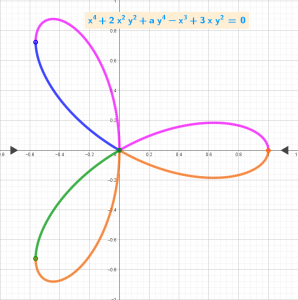Ellipses and Hyperbolas defined geometrically as locus of points
Inspired by material from Wikipedia: [url=https://en.wikipedia.org/wiki/Ellipse#Definition_as_locus_of_points]Ellipse[/url] and [url=https://en.wikipedia.org/wiki/Hyperbola#As_locus_of_points]Hyperbola[/url] as locus of points. [br]
Finding explicit expressions of four real functions for an implicitly defined plane curve (Trifolium curve) whose equation is biquadratic in the variable y
[size=85]x⁴ + 2x² [b]y²[/b] + a [b]y[/b]⁴ - x³ + 3x [b]y²[/b] = 0 [br] Biquadratic equation, the solution [b]y[/b]=y([b]x[/b]) of which is found by the formulas[url=https://eqworld.ipmnet.ru/en/solutions/ae/ae0104.pdf] EqWorld[/url]. The branches of the implicit function generally correspond to the real functions f(x) on the considered domains of definition of the implicit function.[br] The vertical asymptotes are found using the [url=https://en.wikipedia.org/wiki/Implicit_function_theorem]implicit function theorem[/url] and the calculations are done in CAS.[br] *Following [url=https://www.geogebra.org/m/kwdbdznt]applet[/url]: Branches of an implicitly defined biquadratic curve found using complex functions.[/size]
An example of finding explicit equations for curves using complex functions that make up an implicitly defined cubic curve
[size=85][u][b]Statement of the problem:[/b][/u][br]The curve is given in [b]implicit[/b] form as g(x, y) = 0, for example a circle as y² + x² = 1.[br][u][b] Find:[/b][/u][br]the [b]explicit [/b]form of the equations y=f(x) for each of the [b]k[/b] branches of the curve, i.e. {f[b]ᵢ[/b](x)}, where i=1..k. For a circle, for example, f₁(x) = sqrt(1-x²) for y > 0, and f₂(x) = − sqrt(1-x²) for y < 0. If f(x, y) is a quadratic function with respect to variable [b]y[/b], GeoGebra can easily find the [b]roots [/b]in symbolic form, y₁(x) and y₂(x).[br] For polynomials of the 3rd and 4th degree, knowing the existing rigorous [url=https://www.geogebra.org/m/v4fvf8nx][u][b]solutions[/b][/u][/url] of their equations in symbolic form, one can find the equations of the branches {f[b]ᵢ[/b](x)} of the corresponding plane curves using complex functions.[br] Earlier, I considered biquadratic equations for the [url=https://www.geogebra.org/m/kwdbdznt][u][b]Trifolium curve[/b][/u][/url] and the [url=https://www.geogebra.org/m/cgfbcxau][u][b]Cartesian oval[/b][/u][/url]. These examples illustrate the application of complex functions. In these cases, it is possible to find the equations of the branches of curves using both [i][b]real functions[/b][/i] and [i][b]complex functions[/b][/i], from the real part of the functions of which only those sections are left where the corresponding complex part is missing, i.e. Im(x)=0.[br][/size][size=85] This applet considers an example from mathstackexchange: [url=https://math.stackexchange.com/questions/3980344/branches-of-implicitly-defined-cubic-curves]Branches of implicitly defined cubic curves[/url] for an implicitly defined cubic curve [b]a y³ + b y² + c y + d(x) = 0 where d(x)=-5 x³ + x² + 45x - c0[/b], for which I found explicit equations of the curves of its branches using complex functions.[br] Images of three examples are in the [url=https://www.geogebra.org/m/rek5mz4n]applet.[/url][/size]
An example of finding explicit equations for curves using exact roots as complex functions that make up an implicitly defined quartic plane curve whose equation has 15 coefficients
[size=85] This applet illustrates an example of finding equations of branches of a plane curve of degree four (specified implicitly) using existing[b][url=https://www.geogebra.org/m/v4fvf8nx] rigorous solutions[/url][/b] in the form of complex functions in symbolic form.[br] The [b] [url=https://en.wikipedia.org/wiki/Quartic_plane_curve]Quartic plane curve[/url] [/b]of the [b]fourth order [/b]has 15 coefficients: A [b]x[/b][sup][b]4[/b][/sup]+B [b]y[sup]4[/sup][/b]+C [b]x[sup]3 [/sup]y[/b]+D [b]x[sup]2 [/sup]y[sup]2[/sup][/b]+E [b]x y[sup]3[/sup][/b]+F [b]x[sup]3[/sup][/b]+G [b]y[sup]3[/sup][/b]+H [b]x[sup]2 [/sup]y[/b]+I [b]x y[sup]2[/sup][/b]+J [b]x[sup]2[/sup][/b]+K [b]y[sup]2[/sup][/b]+L[b] x y[/b]+M[b] x[/b]+N [b]y[/b]+P=0, where at least one of A, B, C, D and E is non-zero. You can explore these curves by adjusting the coefficients using the sliders.[br] Images of three examples are presented in the [url=https://www.geogebra.org/m/wmwsrksg]applet[/url][b].[/b][br][/size]
